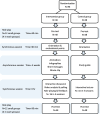Shedding light on the effects of conflict management training: A multi-rater assessment shines a spotlight on medical students' skills
- PMID: 40540476
- PMCID: PMC12180622
- DOI: 10.1371/journal.pone.0325499
Shedding light on the effects of conflict management training: A multi-rater assessment shines a spotlight on medical students' skills
Abstract
Background: Medical students are repeatedly exposed to challenging situations while working with healthcare teams, so acquiring conflict management skills is necessary. This study aimed to investigate the effect of an educational intervention on the conflict management skills of medical students using self- and observer-assessment.
Methods: This educational intervention with a pre-and post-test design was conducted in 2022-2023. Second-year medical students of Tehran University of Medical Sciences volunteered to participate in a randomized study with a control group. The participants were divided into two intervention (12 groups of 4 each, n = 48) and control groups (12 groups of 4 each, n = 48). The intervention group was educated based on the Fogg model, and the control group was trained using conventional method. Student conflict management skills were evaluated using a self-assessment checklist and observer-assessment.
Results: The findings of observer-assessment revealed that the post-test rating in the intervention group was significantly higher than the control group, while the pre-test score in the two groups did not indicate a significant difference (P = 0.03; ES = 0.44 and P = 0.30; ES = 0.18, respectively). Moreover, the comparison between pre-test and post-test in the two intervention and control groups also showed that the educational intervention significantly increased the mean score of the post-test in both the intervention and control groups (P ≤ 0.001; ES = 0.97 and P ≤ 0.001; ES = 1.34, respectively). The comparison between pre-test and post-test in the two intervention and control groups via self-assessment showed that the skill score increased only in the intervention group (P = 0.02; ES = 0.48 and P = 0.98; ES = 0.004, respectively).
Conclusion: This study found that using the Fogg model in e-learning platforms enhances medical students' conflict management skills, highlighting the effectiveness of well-designed, creative, and active model-based teaching methods.
Copyright: This is an open access article, free of all copyright, and may be freely reproduced, distributed, transmitted, modified, built upon, or otherwise used by anyone for any lawful purpose. The work is made available under the Creative Commons CC0 public domain dedication.
Conflict of interest statement
The authors have declared that no competing interests exist.
Figures
Similar articles
-
The educational effects of portfolios on undergraduate student learning: a Best Evidence Medical Education (BEME) systematic review. BEME Guide No. 11.Med Teach. 2009 Apr;31(4):282-98. doi: 10.1080/01421590902889897. Med Teach. 2009. PMID: 19404891
-
Blending electronic techniques with traditional teaching methods to enhance chest X-ray interpretation in medical students.PLoS One. 2025 Aug 6;20(8):e0328159. doi: 10.1371/journal.pone.0328159. eCollection 2025. PLoS One. 2025. PMID: 40768399 Free PMC article. Clinical Trial.
-
Psychological and/or educational interventions for the prevention of depression in children and adolescents.Cochrane Database Syst Rev. 2004;(1):CD003380. doi: 10.1002/14651858.CD003380.pub2. Cochrane Database Syst Rev. 2004. Update in: Cochrane Database Syst Rev. 2011 Dec 07;(12):CD003380. doi: 10.1002/14651858.CD003380.pub3. PMID: 14974014 Updated.
-
Physical exercise training interventions for children and young adults during and after treatment for childhood cancer.Cochrane Database Syst Rev. 2016 Mar 31;3(3):CD008796. doi: 10.1002/14651858.CD008796.pub3. Cochrane Database Syst Rev. 2016. PMID: 27030386 Free PMC article.
-
Nutritional interventions for survivors of childhood cancer.Cochrane Database Syst Rev. 2016 Aug 22;2016(8):CD009678. doi: 10.1002/14651858.CD009678.pub2. Cochrane Database Syst Rev. 2016. PMID: 27545902 Free PMC article.
References
-
- Edgar L, McLean S, Hogan SO, Hamstra S, Holmboe ES. The milestones guidebook. ACGME. 2020.
-
- Bainbridge L, Regehr G. Should there be an “I” in team? A new perspective on developing and maintaining collaborative networks in health professional care. Interprofessional client-centered collaborative practice: What does it look like. 2015. p. 51–66.
Publication types
MeSH terms
LinkOut - more resources
Full Text Sources


